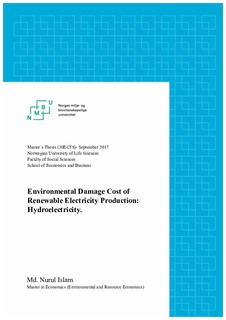| dc.description.abstract | Environmental damage and its costs have been given priority in modern production pattern in the rapid global climate change circumstances. As a key input factor, electricity (energy) and its increasing demand boost up its excessive production to meet the increasing demand all over the world.
Having scarcity in input factors of producing electricity (non-renewable sources) and its increasing trends of price, renewable sources (hydroelectricity, wind energy, solar energy, Bio-thermal and nuclear energy production) have been given priority for research and development and finding out the way of its lucrative production and distribution by the most developed and developing countries at the present world.
To keep pace with the excessive demand shifting from non-renewable sources to renewable sources, measuring and inclusion of environmental damage costs in the production pattern is appeared as a core concern for the Environmental Economists. To set-up the caps and trades of these sources of energy production, a policy maker needs to know its production pattern, land use, damages of human and wild life, nature of emission to the water and air (both in long and short term) to make sure that all impact costs of environment due to this production are well defined and included into the main CBA analysis of any project of this sector.
In this changing scenario of electricity production, my concern of this study is to find out the costs of Environmental Resource and Ecosystem damage costs due to the renewable electricity production, particularly hydroelectricity as it is considered as the matured, reliable and cost-effective source of renewable electricity production (Brown 2011).
The measurement process as well as the methodologies which are widely used in this cases are not adequate to explain all probable damages and their associated costs arise from the production of electricity using the renewable resources. It is now a huge debate among the environmental economists that it’s high time to study more about highly environmentally sensitive projects like hydroelectricity generation, to make sure that all the associated costs can be reflected properly in the Cost-Benefit Analysis of this project to avoid any serious environmental damage and its remedial processes to safe our environment for the better future world. | nb_NO |

